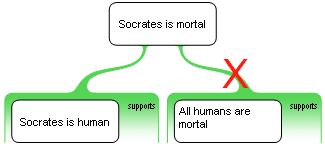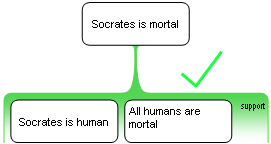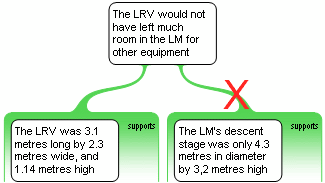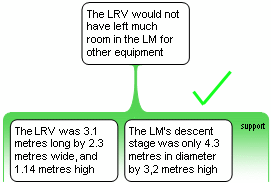
 |
|
|
|
|
| 3.6 Stranded Co-premises | |
Another common mistake - the flip side of the previous one - is putting co-premises of a single reason into separate "reasons". If you do this, the co-premises are stranded from each other; they are not diagrammed as belonging together.
 |
 |
| Discussion |
Consider this example from Apollo Moon Landings, which we already saw in Tutorial 2:
The Lunar Roving Vehicle, was 3.1 metres long by 2.3 metres wide, and 1.14 metres high. As the Lunar Module's descent stage was only 4.3 metres in diameter by 3.2 metres high, one might think this would not have left much room for the remaining equipment. [8.4]
Two separate claims are made as part of the evidence that the Lunar Roving Vehicle would not leave much room for other equipment. But these are not two separate arguments. Rather, they are two interlocking parts of one argument.
 |
 |
Notice that if you applied the Rabbit rule to either of the reasons in the first (two reason) argument map, you'd see right away that there was at least one co-premise, and that co-premise would have to involve one of the key items in the other reason. More generally, applying the Rabbit and Holding Hands principles will quickly reveal that the premises belong together as parts of one argument rather than separate arguments.
| New Concepts |
Stranded co-premises: Two premises are stranded from each other when they in fact belong together as part of one reason but are diagrammed as belonging to separate reasons.
| Glossary | Contents | |
|
Copyright © Critical Thinking Skills BV - |
|